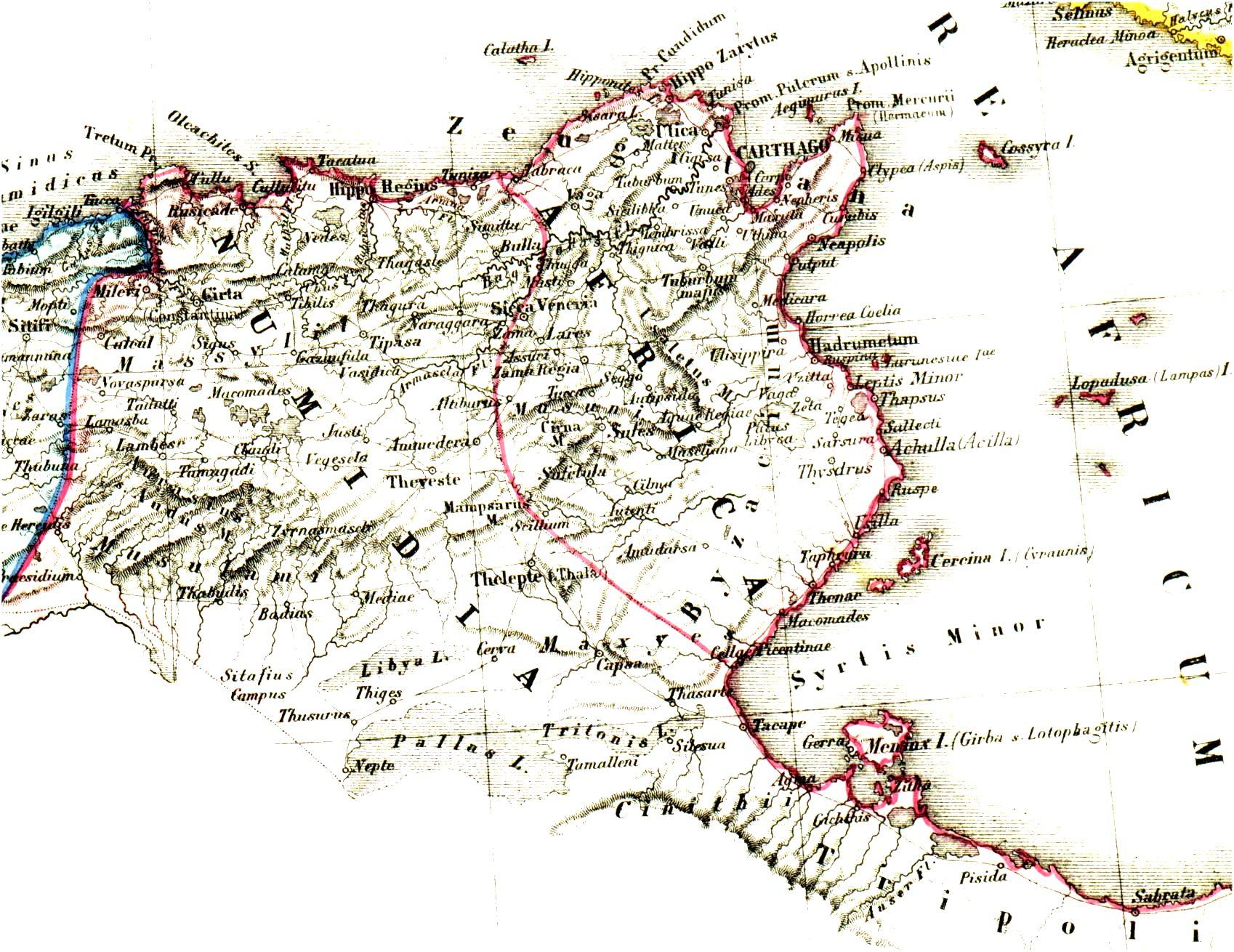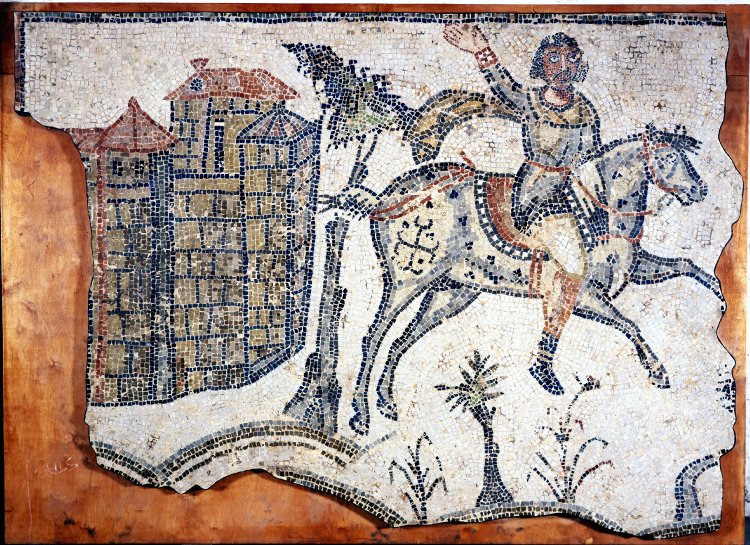|
Thubursicum
Khamissa, ancient ''Thubursicum Numidarum'' or ''Thubursicum'', is an Ancient Rome, Ancient Roman and Byzantine Empire, Byzantine archeological site, in Souk Ahras Province of northeastern Algeria.Princeton Encyclopedia: Khamissa (''Thubursicum Numidarum'') . accessed Oct . 12 . 2013 Geography Khamissa is located southeast of Guelma, the coastal city known as ''Calama'' by ancient Roman settlers, and northwest of Souk Ahras, known as ''Thagaste'' by ancient Berbers and Romans. It was around west of ancient Carthage.History Originally the site was a primary settlement of an indigenous Berber people, Berber tribe of Numidia. This city is probably ...[...More Info...] [...Related Items...] OR: [Wikipedia] [Google] [Baidu] |
Tacfarinas
Tacfarinas ( Latinised form of Berber Tikfarin or Takfarin; died AD 24) was a Numidian Berber from Thagaste, located in the province of Proconsular Africa (now Souk Ahras, in Algeria), who was a deserter from the Roman army who led his own Musulamii tribe and a loose and changing coalition of other Berber tribes in a war against the Romans in North Africa during the rule of the emperor Tiberius (AD 14–37). Though Tacfarinas' personal motivation is unknown, it is likely that the Roman occupation under Augustus of the traditional grazing grounds of the Musulamii was the determining factor. Nevertheless, Tacfarinas' large-scale raids caused severe disruption of the province's grain production, which in turn threatened civil disorder in Rome. The Romans were for a long time unable to eradicate their enemy because of the Numidians' extraordinary mobility and their support from the many desert tribes. Tacfarinas was finally captured and killed in AD 24 by a combination of determine ... [...More Info...] [...Related Items...] OR: [Wikipedia] [Google] [Baidu] |
Souk Ahras
Souk Ahras ( Berber: ''Tagast''; ancient name: ''Thagast''; ar, سوق أهراس) is a municipality in Algeria. It is the capital of Souk Ahras Province. The Numidian city of Thagaste (or Tagaste), on whose ruins Souk Ahras was built, was the birthplace of Augustine of Hippo and a center of Berber culture. It was a city of great culture, described as the very hub of civilization. Etymology The name derives from the Arabic word '' souk'' which means "market", and the Chaoui Berber word ''ahra'' (plural ''ahras'') which means "lion", in reference to the Barbary lions which existed in the neighboring forests until their extinction in 1930; hence ''Souk Ahras'' means "market of lions" (see also Oran (''Wahran'') and Tahert for names with a related etymology). Number of ''wild'' animals killed in Souk Ahras between 1877 and 1892 Source : Dr.Rouquette, Monographie de la commune Mixte de Souk Ahras, 1904, p. 274 The old name of the Numidian city of Thagaste, derives from th ... [...More Info...] [...Related Items...] OR: [Wikipedia] [Google] [Baidu] |
Roman Theatre (structure)
Roman theatres derive from and are part of the overall evolution of earlier Greek theatres. Indeed, much of the architectural influence the Romans came from the Greeks, and theatre structural design was no different from other buildings. However, Roman theatres have specific differences, such as generally being built upon their own foundations instead of earthen works or a hillside and being completely enclosed on all sides. Buildings Roman theatres were built in all areas of the Empire, from Spain to the Middle East. Because of the Romans' ability to influence local architecture, we see numerous theatres around the world with uniquely Roman attributes. Similarities exist between the theatres and amphitheaters of ancient Rome. They were constructed out of the same material, Roman concrete, and provided a place for the public to go and see numerous events. However, they are two entirely different structures, with specific layouts that lend to the different events they held. Amp ... [...More Info...] [...Related Items...] OR: [Wikipedia] [Google] [Baidu] |
Municipium
In ancient Rome, the Latin term (pl. ) referred to a town or city. Etymologically, the was a social contract among ("duty holders"), or citizens of the town. The duties () were a communal obligation assumed by the in exchange for the privileges and protections of citizenship. Every citizen was a . The distinction of was not made in the Roman Kingdom; instead, the immediate neighbours of the city were invited or compelled to transfer their populations to the urban structure of Rome, where they took up residence in neighbourhoods and became Romans ''per se''. Under the Roman Republic the practical considerations of incorporating communities into the city-state of Rome forced the Romans to devise the concept of , a distinct state under the jurisdiction of Rome. It was necessary to distinguish various types of and other settlements, such as the colony. In the early Roman Empire these distinctions began to disappear; for example, when Pliny the Elder served in the Roman army, ... [...More Info...] [...Related Items...] OR: [Wikipedia] [Google] [Baidu] |
Exarchate Of Africa
The Exarchate of Africa was a division of the Byzantine Empire around Carthage that encompassed its possessions on the Western Mediterranean. Ruled by an exarch (viceroy), it was established by the Emperor Maurice in the late 580s and survived until the Muslim conquest of the Maghreb in the late 7th century. It was, along with the Exarchate of Ravenna, one of two exarchates established following the western reconquests under Emperor Justinian I to administer the territories more effectively. History Background In the Vandalic War of 533, Byzantine forces under Belisarius reconquered the Maghreb along with Corsica and Sardinia and the Balearic Islands. Emperor Justinian I () organized the recovered territories as the Praetorian prefecture of Africa, which included the provinces of Africa Proconsularis, Byzacena, Tripolitania, Numidia, Mauretania Caesariensis and Mauretania Sitifensis, and was centered at Carthage. In the 550s, a Roman expedition succeeded in regaining pa ... [...More Info...] [...Related Items...] OR: [Wikipedia] [Google] [Baidu] |
Praetorian Prefecture Of Africa
The praetorian prefecture of Africa ( la, praefectura praetorio Africae) was an administrative division of the Eastern Roman Empire in the Maghreb. With its seat at Carthage, it was established after the reconquest of northwestern Africa from the Vandals in 533–534 by the Byzantine Emperor Justinian I. It continued to exist until 591, when it was replaced by the Exarchate of Africa. History Establishment In 533, the Roman army under Belisarius defeated and destroyed the Vandal Kingdom that had existed in the former Roman territories of Northern Africa. Immediately after the victory, in April 534, the emperor Justinian published a law concerning the administrative organization of the recovered territories. The old provinces of the Roman Diocese of Africa had been mostly preserved by the Vandals, but large parts, including almost all of Mauretania Tingitana, much of Mauretania Caesariensis and Mauretania Sitifensis and large parts of the interior of Numidia and Byzacena, had be ... [...More Info...] [...Related Items...] OR: [Wikipedia] [Google] [Baidu] |
Chapel
A chapel is a Christian place of prayer and worship that is usually relatively small. The term has several meanings. Firstly, smaller spaces inside a church that have their own altar are often called chapels; the Lady chapel is a common type of these. Secondly, a chapel is a place of worship, sometimes non-denominational, that is part of a building or complex with some other main purpose, such as a school, college, hospital, palace or large aristocratic house, castle, barracks, prison, funeral home, cemetery, airport, or a military or commercial ship. Thirdly, chapels are small places of worship, built as satellite sites by a church or monastery, for example in remote areas; these are often called a chapel of ease. A feature of all these types is that often no clergy were permanently resident or specifically attached to the chapel. Finally, for historical reasons, ''chapel'' is also often the term used by independent or nonconformist denominations for their places of wor ... [...More Info...] [...Related Items...] OR: [Wikipedia] [Google] [Baidu] |
Byzantine Architecture
Byzantine architecture is the architecture of the Byzantine Empire, or Eastern Roman Empire. The Byzantine era is usually dated from 330 AD, when Constantine the Great moved the Roman capital to Byzantium, which became Constantinople, until the fall of the Byzantine Empire in 1453. However, there was initially no hard line between the Byzantine and Roman empires, and early Byzantine architecture is stylistically and structurally indistinguishable from earlier Roman architecture. This terminology was introduced by modern historians to designate the medieval Roman Empire as it evolved as a distinct artistic and cultural entity centered on the new capital of Constantinople (modern-day Istanbul) rather than the city of Rome and its environs. Its architecture dramatically influenced the later medieval architecture throughout Europe and the Near East, and became the primary progenitor of the Renaissance and Ottoman architectural traditions that followed its collapse. Characteristic ... [...More Info...] [...Related Items...] OR: [Wikipedia] [Google] [Baidu] |
Vandalic War
The Vandalic War was a conflict fought in North Africa between the forces of the Byzantine Empire and the Vandal Kingdom, Vandalic Kingdom of Carthage in 533–534. It was the first of Justinian I's wars of reconquest of the Western Roman Empire. The Vandals occupied Roman North Africa in the early 5th century, and established an independent kingdom there. Under their king, Geiseric, the Vandal navy carried out pirate attacks across the Mediterranean, Sack of Rome (455), sacked Rome and defeated a Roman invasion in 468. After Geiseric's death, relations with the Eastern Roman Empire normalized, although tensions flared up occasionally due to the Vandals' adherence to Arianism and their persecution of the Nicene native population. In 530, a palace coup in Carthage overthrew the pro-Roman Hilderic and replaced him with his cousin Gelimer. The Eastern Roman emperor Justinian took this as a pretext to intervene in Vandal affairs, and after securing the eastern frontier with Sassani ... [...More Info...] [...Related Items...] OR: [Wikipedia] [Google] [Baidu] |
Hippo Regius
Hippo Regius (also known as Hippo or Hippone) is the ancient name of the modern city of Annaba, Algeria. It historically served as an important city for the Phoenicians, Berbers, Romans, and Vandals. Hippo was the capital city of the Vandal Kingdom from 435 to 439 C.E. until it was shifted to Carthage following the Vandal Capture of Carthage (439). It was the focus of several early Christian councils and home to Augustine of Hippo, a Church Father highly important in Western Christianity. History Hippo is the latinization of ( xpu, 𐤏𐤐𐤅𐤍), probably related to the word ''ûbôn'', meaning "harbor". The town was first settled by Phoenicians from Tyre around the 12th centuryBC. To distinguish it from Hippo Diarrhytus (the modern Bizerte, in Tunisia), the Romans later referred to it as Hippo Regius ("the Royal Hippo") because it was one of the residences of the Numidian kings. Its nearby river was Latinized as the Ubus and the bay to its east was known as Hippo Ba ... [...More Info...] [...Related Items...] OR: [Wikipedia] [Google] [Baidu] |
Coadjutor Bishop
A coadjutor bishop (or bishop coadjutor) is a bishop in the Catholic, Anglican, and (historically) Eastern Orthodox churches whose main role is to assist the diocesan bishop in the administration of the diocese. The coadjutor (literally, "co-assister" in Latin) is a bishop himself, although he is also appointed as vicar general. The coadjutor bishop is, however, given authority beyond that ordinarily given to the vicar general, making him co-head of the diocese in all but ceremonial precedence. In modern times, the coadjutor automatically succeeds the diocesan bishop upon the latter's retirement, removal, or death. Catholic Church In the Catholic Church, a coadjutor is a bishop with papal appointment as an immediate collaborator of the diocesan bishop in the governance of a diocese, with authority to substitute for the diocesan bishop in his absence and right to automatic succession to the diocesan see upon death, resignation, or transfer of the incumbent diocesan bishop. T ... [...More Info...] [...Related Items...] OR: [Wikipedia] [Google] [Baidu] |




.jpg)
